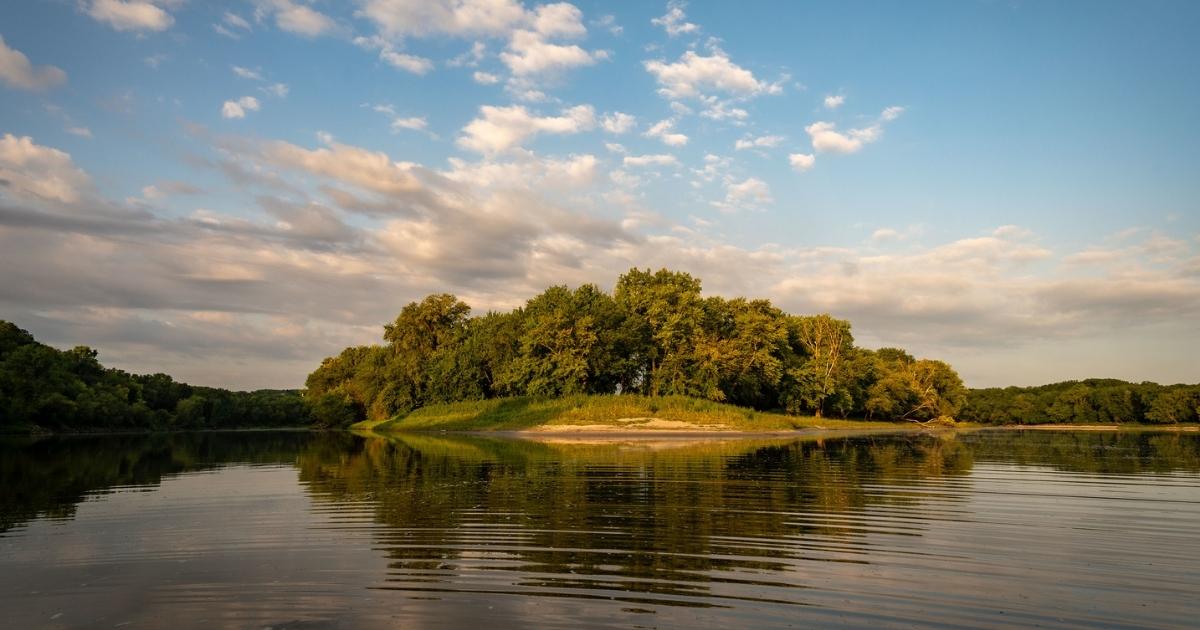Originally published in the April issue of the Notes on Antiracism, Justice, and Equity newsletter.
On a warm and breezy spring afternoon last year, I drove down the narrow gravel roads that lead to Bdoté, just south of the Twin Cities. I didn’t realize then that I’d leave, changed. My relationship to the state where I was born and raised would never be the same.
Alongside School of Public Health (SPH) colleagues and new faces, I participated in an immersive experience called Injustice in our Backyard: The Unspoken History of Genesis & Genocide at Bdoté. Reverend Jim Bear Jacobs, the Founder of Healing Minnesota Stories, led us through an oral history of this sacred place and the people who hold it close.
The Dakota word bdoté means “where two waters come together,” and the physical place – Bdoté – is the convergence of the Mississippi and Minnesota rivers. Jim Bear shared that Dakota people consider it to be the locus of creation, similar to the Garden of Eden for Christians. Pregnant women would walk for days to Bdoté, he said, to deliver their children. The deep historic and spiritual importance of this place cannot be overemphasized.
What came next in the story was a shock to my system but was not shocking. During the U.S.-Dakota War of 1862, Dakota people were detained in a concentration camp on the sacred land at Bdoté. This brief war involved internment, forceful removal, and systematic starvation, and was just one contributing event in the U.S. governmental genocide of Dakota people and other Native Americans living in the state. The U.S. government hanged 38 Dakota men in Mankato in what would become the largest mass execution in U.S. history.
Let’s pause for a moment to reflect on the fact that all of this happened here, in Minnesota. It’s heartbreaking to learn about people suffering – whether it happened yesterday or more than 150 years ago – especially when that suffering was deliberate, systematic, and took place less than eight miles from where you live.
As we reflect on place and history, specifically in the area near Bdoté, it’s also important to note that military officers and civilians who lived at Fort Snelling enslaved African Americans in the decades leading up to the U.S.-Dakota War. Dred Scott and his wife Harriet, known for suing for their freedom in the 1857 Supreme Court case, were enslaved at Fort Snelling for many years. Minnesota and its settler occupants played a prominent role in U.S. imperialism and oppression; what’s included here only represents a small percentage of that.
The persistent notion that racism hasn’t been or isn’t a problem in the state because of our generally progressive values – despite more recent events like the police killing of George Floyd gaining international attention – is dangerous. Denial of racism perpetuates it. And the Bdoté experience served as an opening, an opportunity, for participants to engage with a true story told by those who have occupied this land for thousands of years; much longer than any of my white ancestors.
A common refrain in white circles working toward antiracism is that we should be “listening and learning,” centering the lived experiences, expertise, and stories of racially minoritized people. Yes and, I propose we expand on this by recognizing how we’re listening to better absorb what we’re learning. While at Bdoté, I witnessed participants listening with their full selves; no distractions. People showed up with reverence and vulnerability to bear witness to the stories Jim Bear recounted for us. This collective experience felt as sacred as the ground we stood on.
Bdoté is a reminder that history is not just dates and events but stories woven into the land itself – stories that contain entire belief systems and a spectrum of memories, emotions, and traumas. All of this is connected to our individual and cumulative health. The sacredness of Bdoté, the divinity and pain it holds, and the lessons it offers, profoundly altered the way I view my home. I will carry the weight of what I learned there along with the hope that comes from facing the truth. Sometimes, to engage more deeply with our shared humanity simply requires our full attention.
SPH invites you to join us for another immersive Bdoté experience on Friday, May 16 from 1 to 2:30 p.m. I hope you’ll come with an open heart, ready to engage deeply with this chapter in Minnesota’s history. Register using this link.
Additional resources to explore:
- Bdoté Memory Map (Interactive Website – Minnesota Humanities Center)
- Bdoté is Sacred (Video – Twin Cities Public Television)
- Learning From Place: Bdoté (Article – MinnPost)
A special thanks to the school’s Office of Diversity & Inclusion and Division of Epidemiology and Community Health for planning our visits to Bdoté.

